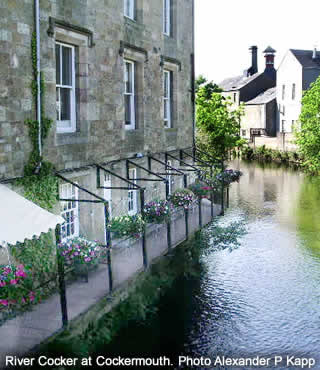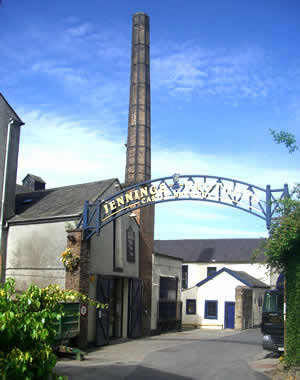Cockermouth |
|
 |
|||
Britain > Lake District > Cockermouth |
|||||
A market town at the meeting of two rivers |
|||||
|
|||||
On the north-western border of the Lake District, the River Cocker flows into the Derwent. This point has always been the best place to cross both waterways. The Romans realised this, so they built a fort and started a settlement. The resulting traffic soon turned it into a successful market town. |
|||||
However, in 2009, the rivers that brought such prosperity nearly took everything away again. They burst their banks after heavy rainfall, flooding the streets and wrecking most of the buildings. At its worst, the water rose as high as 2.5 metres. |
|||||
After the liquid receded, Cockermouth began to recover. It wasn't the first flood and it won't be the last but, as always, the locals set about the repair work with gusto. The town soon began to regain its former charm. |
|||||
The most visible of Cockermouth's buildings is the castle. It takes pride of place on a tall hill, at the very point where the rivers meet. This isn't the original Roman creation; it's a medieval structure from the 13th and 14th centuries. Both the War of the Roses and the Civil War took their toll, and the fort is badly damaged. Nevertheless, the messy ruins, surrounded by trees and flowers, make for a pretty sight. If you want to look around, you'll have to time your visit carefully. The building is privately owned, and it's only open to the public a few times per year. |
|||||
Sitting in the castle's shadow is the Jennings Brewery. Naturally, it's not as old as its neighbour, but this is still a Cockermouth institution. They use only natural ingredients, including Lakeland water drawn from underground. To see the magic happen, you can join one of the guided tours. The staff explain the various stages of the brewing process, and show off the machinery involved. Of course, the finished product is available for tasting at the in-house bar. |
|||||
 Jennings Brewery Photo Mick Knapton (cc) |
|||||
Cockermouth's most famous building is the red Georgian house on Main Street. On the 7th of April in 1770, this is where William Wordsworth was born. He grew up to become one of the most respected poets England has ever produced. The property has been in the care of the National Trust since way back in 1938. Recently, in 2004, they paid £1 million to send the building back in time. It was refurbished to look as it would when the Wordsworths were in residence. This is a lively place, with costumed guides and harpsichord performances. Outside are the colourful gardens, which probably helped kick-start William's interest in nature. Later in life, his vivid descriptions of England's natural landscapes cemented his name in history. |
|||||
|
|||||
On the outskirts of town, at the Lakeland Sheep and Wool Centre, you can meet some of Wordsworth's neighbours. Inside the 300-seat arena, you'll be introduced to 19 different breeds. The staff show just how quickly a sheep can be sheared, before the dogs herd the flock skilfully back into their pen. |
|||||
With attractions like these, some people think Cockermouth is a backwater place that's stuck obstinately in the past. They may even be right, although that isn't necessarily a bad thing. Nevertheless, the town is a bit more forward-thinking than many give it credit for. This is supposedly the first settlement in Britain to try out electric lighting! |
|||||
|
|||||
Cockermouth Tourist Information Centre, Town Hall, Market Street, Cockermouth, CA13 9NP. Tel: 01900 822634 |
|||||
Jennings Brewery is open for tours Monday to Saturday, April to October (Saturdays only in winter), at 11am and 2pm. Booking Essential. Tours cost around £8. Jennings Brewery, Castle Brewery, Cockermouth, CA13 9NE. Tel: 0845 1297185 |
|||||
|
Pocket Britain is optimised for use on a smartphone or tablet with internet access. All content is subject to copyright. All reasonable methods have been used to ensure information supplied is accurate at the time of publication. However, it is advisable to check information before relying on it. Privacy Policy |